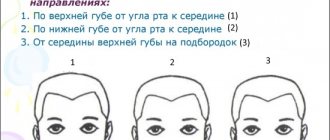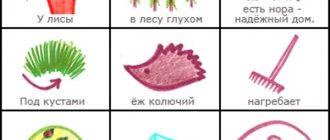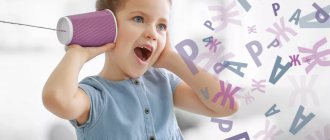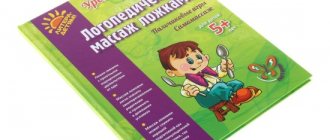“The white-sided magpie was cooking porridge and feeding the children.” Remember the words of the children's nursery rhyme? Can you name the finger that didn't get the porridge? If yes, then you are already familiar with finger massage techniques for children. It is believed that it needs to be done from the first days of life so that the child develops speech correctly. Let's figure out whether this is really so and how to massage children of different ages.
Why do finger massage?
The first two years of life play a very important role in the development of a child. At this time, the baby develops cognitive abilities: memory, the ability to perceive and analyze information, as well as transmit it through speech, gestures and movements. Therefore, communication with mom and other close, loving people is necessary for the baby just like food, warmth and healthy sleep. Until the baby learns to speak, this communication will be primarily tactile. When you hug, tickle or pet your baby, you stimulate his sensory receptors - nerve endings that send signals to the brain and make it work.
There are a lot of receptors on the baby’s arms, and the areas in the cerebral cortex that are responsible for fine motor skills of the hands and speech are very close and have areas of overlap. This means that when you touch your baby's fingers and hands, you are training his cognitive abilities.
Massage with walnuts
Using walnuts, you can massage your wrist, hands, palms, fingers, and the backs of your hands.
- hide the nut in a tightly clenched palm (first in one hand, then in the other);
- Using the fingertips of one hand, screw the nut into the middle of the palm of the other hand;
- roll the nut over the surface of the palm lying on the table, from the tips of the fingers to the wrist;
- roll the nut from the back of the hand (as if from a hill);
- roll the nut between your palms from your fingers to your wrist and back;
- roll the nut over the table surface with your palm in a circular motion;
- hold the nut between the fingers of both hands, folding them into a pinch.
When should you start finger massage of your child’s hands?
Hands need to be massaged from birth. True, for now it will be little like a real massage. Light stroking and pressing are enough, as well as exercises to develop the grasping reflex: just bring your finger or small toys to the child’s hands so that he can grab them.
When the child turns one year old, you can move on to nursery rhyme games. For example, the familiar “White-sided Magpie”. Read a poem to your baby: while the magpie is preparing porridge, move your index finger in a spiral along your palm, and when the bird starts feeding the chicks, bend the baby’s fingers one by one. Such activities engage surface receptors on the child’s hands. Thanks to the fact that you pronounce all the actions, the baby at the same time learns to connect your speech with actions and objects.
From the age of two we begin to move on to massage that stimulates deep pressure receptors. To do this, you can use massage balls with pimples, which need to be rolled over the child’s palms and fingers, pressing lightly. At this age, the baby is already able to perform exercises to develop fine motor skills: grab and touch small objects. It is important that he does this under adult supervision, because the baby may want to see if he can fit this part into his nose or ear.
For school-age children who begin to write unusually a lot, it is useful to have a relaxing hand massage. To do this, massage the child’s hand with circular squeezing movements from the back, then pay attention to each finger and also massage from the nail to the base. After this, use your thumbs to massage the baby’s palm in a circular motion.
It is useful to teach your child how to do this massage on his own, so that he can use it if his hands get tired during lessons or doing homework. If he still can’t remember all the movements, teach him the game “We wrote, we wrote, our fingers were tired.” Let him clench and unclench his hands into a fist for a few seconds, this also helps to relax his hands.
Hand massage
The success of the development of a child’s intelligence and speech lies in massaging the hands. Exposure to them promotes active and coordinated work of both hemispheres of the brain. Speech therapy massage is also important for speech development.
Massage will help strengthen the muscles of the hand. It will speed up the development of your baby’s speech, memory, thought processes, and will also prepare his hands for writing in the future.
To knead and massage your hands, take auxiliary objects. Pencils (they can be rolled between your palms and along the back of your hand), a ball with pimples, a bowl of cereal or beans, and walnuts will be excellent helpers.
Invite your baby to hold them in his hands, roll them along his arms, legs or table surface.
When giving a massage, turn it into a fun game:
"House"
This is our house. (Place your hands together with your fingers.)
And here is its roof. (Interlace the fingers of both hands.)
Where is the pipe in it? She's even taller. (All fingers up)
"Hedgehog"
A prickly hedgehog lives in the forest, (roll the ball on the table) But he doesn’t have legs, he runs on my fingers (roll on my legs and arms) And he puffs very loudly. He runs quickly through the forest and tickles me! I’ll tell him: prickly hedgehog, run to where you live!
How to prepare for a massage?
First, warm and stretch your hands. To do this, you can rub your palms together, clench your fists, or hold your hands under running warm water. Make sure that there are no wounds or hangnails on your hands; you will also have to give up manicure with long nails. If the skin on your hands is dry, use a hypoallergenic cream that your baby is used to. When massaging a child in the first year of life, you should not choose essential oils. Choose proven products.
If you notice wounds or allergic rashes on your child’s hands, postpone the massage until they heal or first treat the baby’s skin with a special allergy cream or ointment. After this, you can begin the massage, but do it even more carefully and carefully than usual.
Babies are not always happy about massage. You should not do it if the child is upset or capricious. The procedure should bring him joy and pleasure. Children as young as one year old may have problems with concentration and perseverance during classes. Therefore, turn the process into an exciting game with rhymes, songs and toys and do not prolong the exercise. A few minutes a day for massage is enough.
Button massage
The buttons can be placed in a box or large bowl. It is advisable to have a lot of buttons. First, together with your child, put your hands in the box (bowl), then do the exercises:
- run your palms over the surface of the buttons;
- clasp the buttons into your fists, slightly raise and unclench your fists;
- plunge your hands deep into the button “sea” and swim in it;
- rub the buttons between your palms;
- pour them from palm to palm (first with one hand, then with the other hand, then with both hands),
- grab a “pinch” of buttons and release.
Where can you find ideas for educational games with your child?
If the rhyme about the white-sided magpie no longer captivates your child, new nursery rhymes can be found on the Internet or in books. We've selected three titles that will inspire new ideas for games to develop fine motor skills.
“Finger games. The white-sided magpie was cooking porridge.” The book contains nursery rhyme games with detailed illustrations of how to do the exercises, as well as ideas for organizing a finger theater with children.
“Fun educational games. From birth to three years.” The author of the book, Sally Goldberg, explains how a child's brain and cognitive abilities develop at an early age, and gives exercises that help with this.
"Open and close." Biologist Lucy Felix came up with and drew a book in which a child follows the adventures of a white mouse, and at the same time does exercises for fine motor skills and learns colors and shapes.
Development of fine motor skills using improvised tools
In the modern world, the industry has undoubtedly expanded greatly: there is a large amount of literature for the development of fine motor skills, but their cost is not budgetary. During the lesson it is possible to use items made independently.
The first thing you can introduce your baby to is lacing. To make the game, you will need cocktail tubes, which you need to cut into small pieces and thread the string inside. It is allowed to thread the lacing into the tubes randomly, but with older children, you can complicate the task by coming up with a certain sequence, sorting the tubes, alternating them by color.
Don't throw away your old markers, you'll really need them too. After disconnecting the caps from the markers, try to put them back on with your child. This is a great color vision task. It is advisable to remove the remaining ink rod when playing.
Use a quail testicle cell. From the reverse side, decorate the cell with acrylic paints of primary colors. Make quail-size eggs in the appropriate colors from salt dough or plasticine. Invite the little one to arrange the eggs by color, in certain cells. Testicles are a good visual material for teaching counting.
Next, let's look at a tool such as clothespins. They can be purchased at any hardware store. And now, fortunately for all teachers and parents, they have appeared in the main color scheme. Make a sun out of cardboard. Can be used to study emotions. “The sun became sad without its rays. Let's make some rays for the sun. What happened? It started smiling!” On the reverse side draw a cheerful luminary.
Read more: Bad advice for parents
The same work can be done with carrots. “Our carrots were sad, they were in the garden. She really wanted to go out into the world.” Let's attach green clothespins - grass - to the orange beauty. Look how happy the carrot has become!
Let's make a bird out of cardboard. You can ask your child to attach a sparrow's tail and wings so that the bird can fly. This exercise will expand the child’s understanding of existing birds.
For the youngest kids, use mosaic. How can it be used? The mosaic was created for children from three years old, as it contains small details. Of course, you need to play only under the strict guidance of adults. Make sure that the baby does not pull small parts into his mouth.
All templates are easy and simple to make. For this age period, your artistic skills, for a baby, are in a secondary place, so everything can be done simply in silhouette.
It is important to organize the game situation. “A cloud flew in. It was pouring rain. Droplets dripped onto the ground “drip-drip.” Invite the little one to make raindrops.
The kids really like the mosaic “Spring Tree”. When placing green leaves on the tree, recite the nursery rhyme:
Spring has come to visit us, bringing greenery to all the trees. The birds sang cheerfully, the rays warmed their houses. The bees flew into the hives, ate well on the flowers, and the birch trees wore dresses for weeks, so that the leaves rustled quietly
In cases of autumn weather, you can make a tree with red, yellow or orange leaves.
Autumn gave bright colors. Red, red, gold, All the colors are now with me! I will collect them together, And I will braid the trees.
Place the cut out basket on the mosaic. Ask the little one to fill a basket for Mikhail Potapovich.
Misha walked through the forest. He found some mushrooms. Strawberry, jump into the tub. Bear will eat it on the sly.
It’s very good if you have a bibabo toy. The guys like to have a dialogue with them. Be sure to lead the conversation away from the toy. The little bear should try the berries that the child picked for him and thank the baby for his good work.
To develop color perception, you can make a circle with birds of different colors. Use wooden clothespins and paint the ends with matching colors. Involve your little one in making tails for the birds.
The birds have flown in, they are singing songs, we are singing happily together, we are pecking at delicious grains.
Templates can be made from colored paper and applied to the mosaic or attached using stationery mastic.
Read more: Child crisis: how to survive?
IV. How to massage?
Next, we’ll talk about how to massage a child’s face, use spoons, and perform articulation and finger massage to develop speech.
Logomassage of the face
Follow these instructions, unless otherwise directed by your doctor: when performing a massage, move from top to bottom, try not to strain. Don't forget that your hands are real medicine!
Logomassage with spoons
Spoons allow you to have a good effect on speech areas. Be sure to make sure the spoons have a smooth surface! Any small hangnails can injure a child’s skin! It is enough to repeat all movements 7-8 times.
Articulation massage for speech development
This type of massage requires the use of a spatula or toothbrush. In principle, it can be done by hand. Don't forget to wear medical gloves! Place a sterile cloth nearby to remove saliva. If the child feels pain, stop the session.
Before starting the procedure, it will be useful to relax the child: to do this, massage the collar area, neck muscles and jaws.
Finger logomassage for speech development
Massaging your fingers is the easiest way. There is no need for any serious knowledge or precautions here. All caring mothers and fathers do this. This massage is most useful for children who have not yet turned one year old.
The fact is that the nerve endings of the hands are considered to be connected to the speech areas in our brain. Therefore, finger massage can improve the baby’s speech. To enhance the effect, you can use a rubber ball.
All the procedures described really make it possible to correct sound pronunciation, form correct speech breathing, strengthen the voice and stabilize the emotional state. Therefore, we recommend that you perform different types of procedures to speed up speech correction.
Read our article for more details on how to learn to speak beautifully and competently as an adult >>>
Sets of tools for logomassage
Logomassage probes are special instruments made of wire. They are used to mechanically influence the tongue and other organs of the child’s articulatory apparatus. Their use allows you to introduce sounds to your baby and correct speech pronunciation. Probes are an exclusively domestic invention. In the EU and USA, speech therapists do not use probes - they do not even know the technology for handling them!
For the first time, the use of special tools for speech correction was invented by the Russian speech therapist, professor and teacher of the deaf, Fedor Andreevich Rau. He also developed the first forms of probes that are used by speech therapists to this day.
It is customary to divide instruments for logomassage into staged and massage. Staged ones are used for Rau and Volkova therapy, as well as for intermediate techniques.
Massage probes are used in the Novikova technique.
Probes are most often made of steel and wire. In stores you can buy sets of probes for performing different logomassage techniques. Typically, such kits contain from seven to 12 instruments. The sets cost between 2-3 thousand rubles. The following tools may also be useful to perform the procedure:
- massage stick;
- tongue raising device;
- mirror (for examining the mouth);
- wine cork (for articulation gymnastics);
- mouth dilators.









